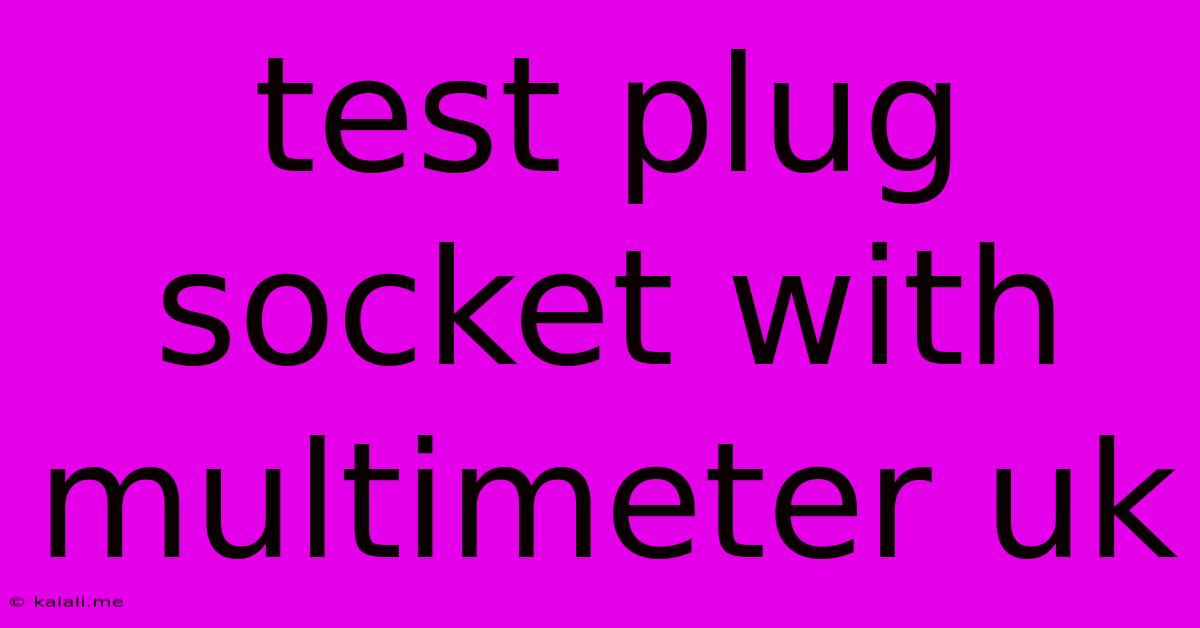Test Plug Socket With Multimeter Uk
Kalali
May 21, 2025 · 4 min read

Table of Contents
How to Test a UK Plug Socket with a Multimeter: A Comprehensive Guide
Meta Description: Learn how to safely and effectively test your UK plug sockets for voltage and earth continuity using a multimeter. This comprehensive guide provides step-by-step instructions and safety precautions.
Electrical safety is paramount, and regularly testing your UK plug sockets is crucial for preventing electrical hazards and ensuring the safety of your home and family. A faulty socket can lead to electric shocks, appliance damage, and even fires. This guide will show you how to test a UK plug socket with a multimeter, a simple yet essential tool for every homeowner. We'll cover checking for voltage and earth continuity, ensuring your sockets are safe and functioning correctly.
What You'll Need
Before you begin, gather the necessary tools and equipment:
- A Multimeter: This is the primary tool for testing the socket. Make sure it's suitable for AC voltage measurements.
- A Test Probe: Your multimeter should come with test probes. Ensure they are in good condition.
- Screwdriver (Phillips head): You might need this to access the fuse box if you're troubleshooting a larger electrical issue. This step will only be needed if your multimeter readings indicate a problem with the power source, not the socket itself.
Safety Precautions: Prioritize Safety!
- Turn off the power: Before you begin any testing, always switch off the power at the consumer unit (fuse box) to the circuit you are testing. This is the most crucial step to ensure your safety.
- Double-check: After turning off the power, double-check using a light switch or appliance on the same circuit to ensure the power is completely off.
- Don't rush: Take your time and carefully follow each step. Rushing can increase the risk of accidents.
- Use appropriate safety equipment: While testing a domestic socket usually doesn't require heavy-duty protective gear, consider using insulated gloves for extra precaution.
- If unsure, consult a professional: If you're uncomfortable performing this test, it's always best to consult a qualified electrician.
Testing for Voltage
- Set your multimeter: Set your multimeter to measure AC voltage (usually indicated by "VAC" or a similar symbol). Select a range appropriate for your mains voltage (230V in the UK).
- Connect the probes: Carefully insert the test probes into the live (L) and neutral (N) sockets. Do not touch the metal parts of the probes while the multimeter is connected.
- Read the voltage: Your multimeter should display a reading close to 230V. A significantly lower reading or no reading at all indicates a problem with the power supply to the socket, not necessarily the socket itself. In this case, you will want to investigate the main circuit breaker and other potential issues with your home electrical system.
- Test the Earth Connection: With the multimeter still set to VAC, connect one probe to the earth (E) terminal and the other to either the live (L) or neutral (N) terminal. You should get a reading close to 230V. A significantly lower reading or no reading can indicate an issue with the earth connection.
Testing for Earth Continuity
This test checks the effectiveness of the earth connection.
- Set your multimeter: Switch your multimeter to measure resistance (usually indicated by "Ω"). Select a low resistance range.
- Connect the probes: Connect one probe to the earth (E) terminal and the other to a known good earth connection. This could be a metal water pipe (ensure it is grounded) or another properly earthed socket that you've already tested.
- Read the resistance: You should get a very low resistance reading (ideally below 1 ohm). A high resistance reading suggests a problem with the earth connection which is a serious safety hazard. If resistance is high, do not use the socket until the issue is resolved by a qualified electrician.
Interpreting the Results
- Voltage test: A reading close to 230V in the live and neutral test indicates the socket is receiving power correctly. A lower reading may suggest a loose connection or a problem further up the electrical circuit.
- Earth continuity test: A low resistance reading signifies a good earth connection, providing protection against electric shocks. A high reading indicates a fault that needs immediate attention from a qualified electrician.
Remember, these tests are for basic safety checks. If you find any issues, do not attempt to repair them yourself. Always call a qualified electrician to inspect and repair any faulty wiring or socket. Your safety is paramount.
Latest Posts
Latest Posts
-
Mac Connecting To Wifi But No Internet
May 21, 2025
-
How To Find Where You Died In Minecraft
May 21, 2025
-
Hope You Had A Good Holiday
May 21, 2025
-
How To Get Paint Out Hair
May 21, 2025
-
How Long Do You Have To
May 21, 2025
Related Post
Thank you for visiting our website which covers about Test Plug Socket With Multimeter Uk . We hope the information provided has been useful to you. Feel free to contact us if you have any questions or need further assistance. See you next time and don't miss to bookmark.